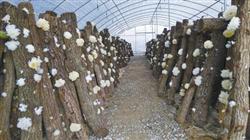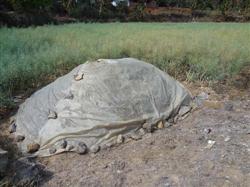Composting and application of organic fertilizer

When composting unripe organic manure, the composting site should be selected in a place of leeward, sunny, and high dry terrain, agricultural film or cement ground should be laid on the composting ground, the livestock manure in farm manure should be caked and broken, and the straw should be crushed below 5 cm to be compacted, and about 3% of calcium superphosphate and dung should be mixed and piled up. The main purpose of adding calcium superphosphate is to prevent the loss of nitrogen in organic fertilizer and increase the activity of microorganisms. After the pile is made, flatten the surface with a shovel, wipe it with mud about 10 centimeters thick or cover it with agricultural film, and press it tightly around to create an anoxic environment and make it mature as soon as possible. The farm manure pile can be mature in about 60 days. When the color of organic fertilizer changes from the original gray to purple and black, the texture is loose and there is a bad smell, it shows that it is mature and should be applied to the orchard in time. When the fully mature shed bar is applied into the orchard, the parts other than the vertical projection of the crown should be selected, and the fertilizer ditch with 30-40 cm wide and 30-40 cm deep should be excavated, and the organic fertilizer should be evenly mixed with appropriate amount of chemical fertilizer (nitrogen, phosphate fertilizer) and topsoil, and then put into the bottom of the fertilization ditch, and finally covered with the bottom raw soil, or spread throughout the orchard, and then turned into the soil layer.
- Prev

How to produce the strain of Tremella fuciformis
The producing areas of Duan Tremella are Tongjiang, Sichuan, Gutian, Fujian, Changbai Mountain in Northeast China and Huangshan Mountain in old Huizhou. The traditional method of planting white fungus is to plant Tremella fuciformis in the wild from March to April, connect it to the cut-down section of raw wood, raise bacteria for 80 to 90 days, and grow out of the ear from July to August. The growth of Tremella.
- Next

Why should we emphasize the combined application of chemical fertilizer and organic fertilizer?
Unrotten organic fertilizers carry a large number of pathogenic microorganisms and parasitic Ascaris eggs. After being applied to farmland, some of them attach to crops and cause direct pollution, while some of them enter the soil to cause indirect pollution. In addition, after the unmature organic fertilizer is applied to the soil, it can only be absorbed and selected by crops after fermentation.
Related
- Fuxing push coffee new agricultural production and marketing class: lack of small-scale processing plants
- Jujube rice field leisure farm deep ploughing Yilan for five years to create a space for organic food and play
- Nongyu Farm-A trial of organic papaya for brave women with advanced technology
- Four points for attention in the prevention and control of diseases and insect pests of edible fungi
- How to add nutrient solution to Edible Fungi
- Is there any good way to control edible fungus mites?
- Open Inoculation Technology of Edible Fungi
- Is there any clever way to use fertilizer for edible fungus in winter?
- What agents are used to kill the pathogens of edible fungi in the mushroom shed?
- Rapid drying of Edible Fungi

